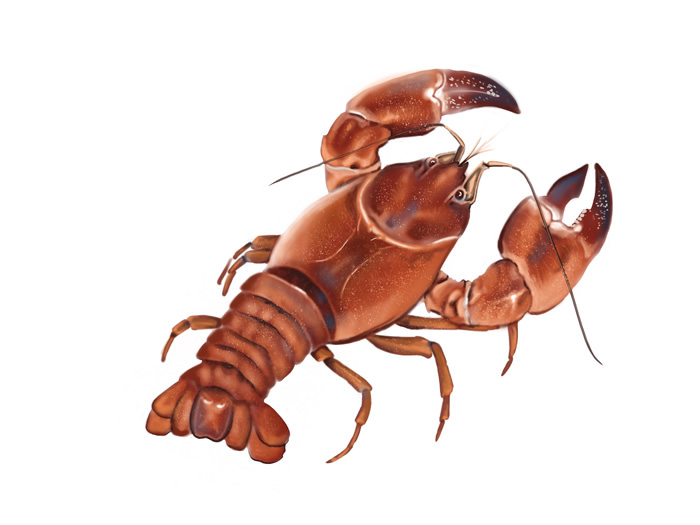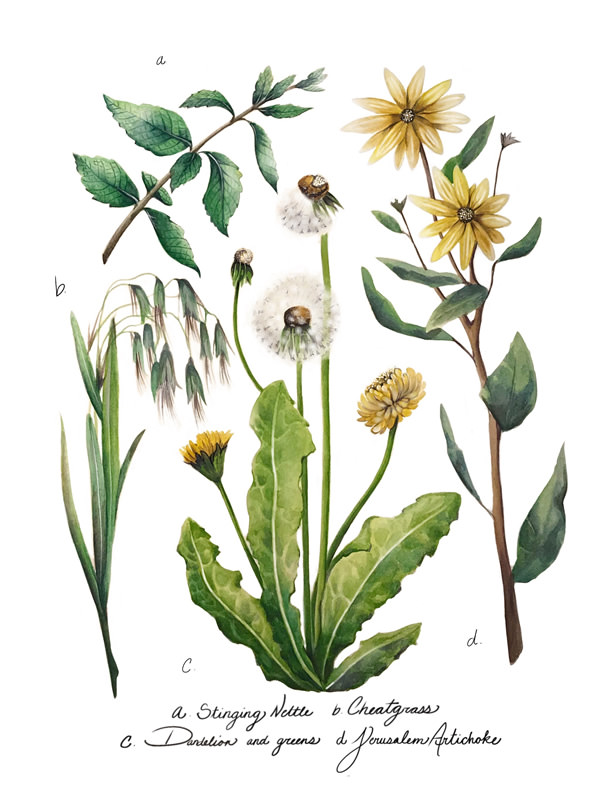edible endeavors
MENACES ON THE MENU
Thoughtful cooking with the area’s invasive species.
WRITTEN BY HEIDI BETHEL
ILLUSTRATIONS BY MEGAN ELLIS
A few years ago, during a daily walk with our dogs, my husband found a large mushroom growing out of an arid crack in the desert ground. He picked it, dreaming of a delicious dinner recipe for green bean casserole sans creamy soup. When he got home, I quickly sent a photo of the bottom of the cap to my father (our family’s fungi expert) to determine whether it was safe to eat. Turns out, it wasn’t and could have been dangerous for us to consume.
That’s the trouble with eating invasive species. It can be hard to tell what is safe to digest and tasty. On the heels of National Invasive Species Awareness Week (Feb. 26 – March 2), we’ve talked with local experts and discovered that — with some knowledge and an adventurous culinary spirit — many commonly found species usually considered pests (and thus not palatable) actually are nutritious food sources.
Planting the unwanted
Wendy Hanson Mazet, horticulturist and horticulture program coordinator for the University of Nevada Cooperative Extension in Reno, often hears from people wanting to control invasive plants, but recently she’s seen more interest in foraging aggressive ones, including dandelions, stinging nettles, and even Jerusalem artichokes.
“When people start looking for these plants, the biggest danger is knowing how they’ve been cared for,” Hanson Mazet says. “Even in your front yard, you don’t know what chemicals and pesticides may have been used to rid the area [of invasives].”
“Many plants that are considered weeds are edible with very distinct flavors,” she continues. “If you want to grow your own, your best bet is in the backyard or a controlled space, where you can keep them clean and handle propagation.”
Grocers and health food stores such as Whole Foods Market carry a variety of invasive plants, many with homeopathic benefits. Stinging nettles and dandelions, for instance, have natural anti-inflammatory qualities that many say help with allergies.
“While they are good for you, stinging nettles can be incredibly painful if handled the wrong way, hence the name. It’s best to purchase them from the store,” Hanson Mazet adds.
Culinary crawfish craze
In the past few years, local crawfish populations have soared and continued to gain traction in local cuisine. This crustacean can grow in number quickly, and there’s been concern that their waste could muck the crystal blue of Lake Tahoe.
Having grown up in Louisiana, David Haggard, owner of Sacks Crawfish, a catering company in Reno, says that crawfish and people who cook and eat them coincidentally have something in common: In much the same way crawfish take over local waters, their lobster-like meat also can be overtaken by seasoning.
“Crawfish take on whatever flavor you mix in with them,” he says. “They absorb seasoning so well, and you can really do a lot. Treat them as you would lobster, crab, or other seafood.”
If you’re on the hunt for the local Lake Tahoe signal crawfish, Haggard also notes that it’s important to learn the permitting regulations for the area first.
“Be sure to get the right licensing. Set some traps, give it 10 to 12 hours, and get the water boiling. You’ll have a really great dinner; just remember the seasoning.”
Whether you try your hand at growing a few dandelions or catching crawfish in area waterways, or head to a purveyor of these commonly found yet not-so-commonly eaten foods, be daring and you may just find one that pleases your palate!
Freelance writer Heidi Bethel remembers catching crawfish with her bare hands in the Humboldt River. Her family always has enjoyed foraging for food … and eating the delicious result when they find the good stuff.

Resources
Interested in eating invasives? Here are a few spots that offer some of these intriguing products.
Great Basin Community Food Co-op
240 Court St., Reno • 775-324-6133 • Greatbasinfood.coop
When in season, find various locally grown invasive plants.
Natural Grocers
4819 Kietzke Lane, Reno • 775-448-9828 • Naturalgrocers.com
Carries many herbal remedies and fresh invasive plants. Find everything from teas to supplements and dried options here.
Sacks Crawfish
775-225-6932 • Sackscrawfish.com
Lake Tahoe signal crawfish are in season from June to October. Sacks Crawfish imports fresh Louisiana crawfish from January to May, but offers Cajun catering services year round.
Whole Foods Market
6139 S. Virginia St., Reno • 775-852-8023 • Wholefoodsmarket.com
Look for fresh and dried invasive plants throughout the year. Processed crawfish tail meat is available in the seafood section.
For details about invasives, including what’s safe to eat and how best to do so, visit Eattheinvaders.org and Nvwma.org.
Recipe
Crab Boil Seasoning
(courtesy of David Haggard, owner, Sacks Crawfish in Reno. Yields 1 cup)
¼ cup salt
4 tablespoons mustard seed
3 tablespoons coriander seeds
2 tablespoons dried dill
1 teaspoon whole cloves
3 tablespoons cayenne pepper
2 tablespoons paprika
2 tablespoons dried thyme
2 tablespoons dried oregano
1 tablespoon garlic powder
2 tablespoons onion powder
5 bay leaves
Combine all herbs in large pot of water and bring to a boil. Add live or raw crawfish, return to boil, and cook 5 to 7 minutes. Enjoy!
Sauce Piquante
(courtesy of David Haggard, owner, Sacks Crawfish in Reno. Serves 6)
1 pound peeled crawfish tail meat
1 tablespoon garlic, minced
½ teaspoon cayenne pepper
2 teaspoons salt
1 tablespoon ground paprika
1 tablespoon onion powder
1 teaspoon dried basil
2 teaspoons black pepper
1 teaspoon chili powder
1 teaspoon oregano
1 teaspoon ground thyme
1 teaspoon brown sugar
1 teaspoon celery seed
1, 8-ounce can tomato paste
1, 16-ounce can tomato sauce
1, 10-ounce can RO-TEL Diced Tomatoes and Green Chilies
½ cup butter
½ cup flour
1 bag vegetable medley (or, alternatively, use 1 onion, chopped, plus 1 bell pepper, chopped)
In 5-quart skillet or pot, sauté vegetables with a little butter to keep from sticking. Once vegetables are translucent, add ½ cup butter and melt thoroughly to begin making roux. Add flour and stir constantly at medium heat until you achieve a medium to dark-brown color. When roux is done, add tomato paste, sauce, and RO-TEL, continuing to stir and lowering heat as needed. Add all seasonings. At this point, either add water to thin or continue to cook to thicken sauce. Once desired consistency is achieved, add cooked crawfish meat.
This dish also can be prepared with shrimp, fish, chicken, goose, duck, beef, pork, rabbit, venison, elk, or other meat. Traditionally, it’s served with rice, but it can be thinned and eaten as a stew or soup, or served with sweet cornbread or over pasta.


